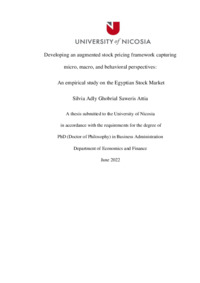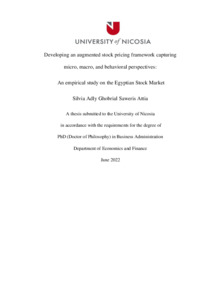-
Starting from the emergence of the stock markets, researchers and investors have become interested in understanding how the stock markets work and how to achieve the best return from these markets under future uncertainties. That had led to the development of various theories and approaches, starting with the efficient market theory and the Capital Asset Pricing Model (CAPM) moving to Arbitrage Pricing Theory (APT) and different microeconomic models, while recently the behavioral and neurological theories have been introduced. However, none of these theories are sufficient to provide full coverage regarding the factors affecting stocks’ pricing. Additionally, the developments witnessed in the stock markets all over the world and the changes shown in human nature increased the necessity of considering rational and irrational sources of risk while making investment decisions. Yet to date, there is not a model that considers both sources of risks. Accordingly, this thesis is intended to develop an augmented framework that captures stocks’ pricing determinants. The introduced framework represents an integration of the microeconomic, macroeconomic, and behavioral finance theories after extracting the most significant variables. The microeconomic model employed in this study is the Fama and French five-factor model, which involves market beta, size, value, profitability, and investment. The macroeconomic model includes five selected variables, three of which are domestic macroeconomic variables and two global factors: exchange rate, inflation rate, industrial production index, federal fund rate, and global commodity index. As for the behavioral model, the variables were gathered by conducting a systematic literature review on the behavioral studies. To reach this aim, the study adopted an empirical study on the Egyptian stock market as a leading emerging market through employing two quantitative methodologies. The microeconomic and macroeconomic models were analyzed using Ordinary Least Square (OLS) method to determine the most significant variables on portfolios’ excess return while using monthly data for the period from June 2010 to June 2020. The behavioral conceptual model was tested using a structured survey. The survey data were analyzed using SEM and multiple regression analysis to validate the built conceptual behavioral model and extract the most significant variables affecting the Egyptian investors’ investment decisions.
The results of the microeconomic model analysis revealed the significance of the size (SMB), value (HML), and profitability (RMW) variables while the macroeconomic model analysis showed the significance of the industrial production index (IPI). The SEM results detected the significance of representativeness, availability, anchoring, and overconfidence bias. The results of this study have both theoretical and practical contributions. The theoretical contribution is highlighted in the developed augmented conceptual framework, which represents a foundation stone subject to updates in further work, in addition to enriching the literature of the three theories: micro, macro, and behavioral. The practical contribution is also shown in the developed augmented conceptual framework, which can be examined in various markets to develop a customized applied framework to fit each economy solely. Moreover, financial advisors can use these results to improve the financial advice provided, while policy makers and government can enhance the investment environment.
Developing an augmented stock pricing framework capturing micro, macro and behavioral perspectives: An empirical study on the Egyptian Stock Market.
- PhD thesis
- english
-
- Business Administration -- Economics and Finance



